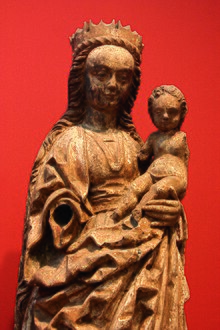Winser Madonna – Wikipedia

The Winser Madonna Is a Gothic Moon Madonna made of linden wood from around 1490. It was in the Marienkapelle 500 years ago, which was in the tower. At that time that was the entrance to the church of the St. Johannes of the Baptist community in Lower Saxony Winsen (Aller). Today the Winser Madonna is owned by the Würth Collection and can be seen in the permanent exhibition in the Johanniterkirche, Schwäbisch Hall.
The figure is 127 cm high, 41 cm wide and 27 cm deep. It weighs about 40 kg. In the 19th century. it was painted over with color. Under the light brown coat of arms, color residues of an earlier version could be determined in the State Office for the Preservation of Monuments in Hanover. The hair is kept in reddish brown. The face has red cheek red, a red eyeliner, blue iris and black pupils. The coat sides are blue and the outside and the cord strap of the crown are kept in gold. [first] [2] On the Winser Madonna, the right arm of the Madonna and both arms and feet of the child are missing, the crowns of the crown and the crescent horns. Probably an infestation from wood -destroying insects has led to this loss. [first]
“The Winser Madonna wears soft, human features. She is not the queen of heaven that prevails in the clouds over the earth or world, but rather as a facing mother of Jesus with a view down towards Earth. Maria is shown as a very young Madonna with robe in heavy folds. It stands on a half -sichel of the moon, which was preferred as a stand area in northern Germany. This stand area is interpreted in art history as an indication of transience or the earth. ”

The Madonna was created around 1490 by an Osnabrück master [3] And still stood in the Winser Church during the Reformation period. After that, the traces lose. It could have been removed from the church in 1597 or during the Thirty Years’ War. Some suspect that it was kept somewhere in Winsen. In 1861 she came to the collection for the Welfenmuseum – there she appeared in an inventory directory in 1863. In 1943 she first came to the Blankenburg and then on the Marienburg to ensure during the Second World War. By chance, it was discovered by the parish of Winsen in 1969 in the possession of the Welfenhaus. In 2005, the collector Reinhold Würth bought the Winser Madonna on an auction in London. [first] [2] [4]
- around 1490 emergence of the sculpture
- Mention of the sculpture in a “legacy of Ilse, the widow of Otto von DAGEFörde”
- During the Thirty Years’ War, vaults and culmbers were richly equipped with pictures from which the imperial soldiers are said to have kneeled and prayed devoutly.
- On June 18, 1861, the commemoration of the Battle of Waterloo, King Georg V (Hanover) called on to emit antiquities for the exhibition in the “Royal Welfen Museum”, which was then founded in 1862.
- In 1863 the Madonna is in the handwritten inventory list of the Welfenmuseum, the later Provincial and from 1933 State Museum in Hanover
- After securing against war effects on Marienburg, the state of Lower Saxony acquired the inventory of the Welfenmuseum in 1955.
- In 2005 the Madonna was bought for the Würth Collection. Due to the mediation of the Lower Saxony Ministry of Science and Culture, there was a contact with Reinhold Würth, which agreed to provide the sculpture of the Winsen parish of St. John the Baptist.
- From 2006 to 2014, the Winser Madonna was seen as a loan in the parish of St. Johannes The Baptist in Winsen an der Aller. [5]
(Information on the time table on the website of the Evangelical Church Winsen/Aller)
- Since 2015, the sculpture has been in the permanent exhibition in the Johanniterkirche in the Schwäbisch Hall in Baden-Württemberg. [6]
- ↑ a b c d The Winser Madonna, side of the Ev. Parish of Winsen
- ↑ a b Press release from the Lower Saxony Ministry of Science and Culture of April 11, 2006
- ↑ This assessment is reproduced by Simon Ziegler in the article of the Celleschen Zeitung “Winsen has to say goodbye to Madonna” on January 12, 2015.
- ↑ The Wins church council has argued that the ownership situation had not been clarified before the auction for 30,000 euros. The figure was outsourced by the State Museum to Marienburg at the end of the Second World War, but it did not go into the property of the Welfenhaus. (As Simon Ziegler in the article of the Celleschen Zeitung “Winsen has to say goodbye to the Madonna” on January 12, 2015)
- ↑ Around the church. In: Evangelical Church Winsenaller. Accessed on September 9, 2019 .
- ↑ Weber, C. Sylvia (ed.): New acquisitions old masters in the Würth. Schwäbisch Hall 2008. p. 113.
Recent Comments